As far as I know, the World’s Grain Conference and Exhibition was a one off event, never to be held in any country before or since. The idea for the conference originated in 1927 as a way to celebrate the triumph of Saskatchewan as a major grain growing centre and also to celebrate the 50th anniversary of agriculture in Regina. Originally, it was planned to take place in 1932 but in 1931 it was postponed until the summer of 1933. The drought and the depression, not envisioned in 1927, were the main culprits.
The World’s Grain Conference and Exhibition was co-sponsored by the City of Regina, the province of Saskatchewan and the federal government of Canada. It took place between July 24 and August 4, 1933 in Regina, combining an academic conference and industrial exhibition with the annual summer fair.
This cartoon was produced when the fair was still scheduled to happen in 1932. There is an editorial in the Regina Leader Post as late as Sep 28, 1931 (scroll up and right) which states that the Grain Show’s future was then still up in the air, even though it had been planned for years and much organizing and spending had taken place. A decision to postpone it until 1933 was made in October.
Some general online sources for information on the exhibition are :
Brief History of Regina brochure online at: https://www.regina.ca/opencms/export/sites/regina.ca/residents/residents-regina-facts/.media/pdf/brief_history_brochure.pdf
Encyclopaedia of Saskatchewan has an entry http://esask.uregina.ca/entry/dogs_world.html
Photographically Illustrated 1933 souvenir booklet at Peel’s Prairie Provinces http://peel.library.ualberta.ca/bibliography/5745.html
I have also found a couple of blog posts which mention specific aspects of the World’s Grain Conference and Exhibition –
https://maryloudriedger2.wordpress.com/tag/saskatchewan-world-grain-exhibition/
http://postalhistorycorner.blogspot.com/2011/10/1933-worlds-grain-exhibition-congress.html
The main source for information in Regina’s Leader Post is the special Grain Show supplement of June 30, 1933 in which you can find a number of illustrations of and stories about the exhibition.
My focus in this blog is on the art shown at the World’s Grain Show but I also want to highlight the Grain Show building, illustrated in this full page introduction to the supplement.
Said to be the largest exhibition building of its kind in the world in 1933, the structure was the focus of the displays and was also decorated with interior murals. It was a rare example of Art Deco architecture in Regina, a city which didn’t build much of anything during the ten year Depression. Because of its size, photographs of it are rare and I haven’t yet seen any photos reproduced in the newspaper of the interior space.
This illustration above, possibly a photograph, gives a better idea of the scale of the building and its Deco elements. A ceremonial entrance to the World Grain Show was also constructed using an echoing design. On Aug. 24, 1931, about the time that the date of the exhibition was in question, it was announced that the building was completed. Construction had begun in February, owing to the mildness of the weather that year, and the building was completely closed in by May. Many of the construction workers were on a relief work program.
Designed by Storey and Van Egmond, a Regina architectural firm, it was the horizontal equivalent in square feet of a New York Deco skyscraper and was framed using steel, although the exterior was clad with wood and stucco, like other one storey buildings. Its dimensions and cost are mentioned in the Aug. 24 cutline and here below in this first illustration of its design, which appeared in the Leader-Post early in 1931.
Fortunately, a floor plan published in the newspaper in the special supplement gives some idea of the commodious nature of the interior and what was housed there during the 1933 show. Occasionally, a photo of decorative items on the inside of the building was reproduced in the newspaper.
The Grain Show building was serving as a storage space for the city and various other businesses and housing a curling rink when a gigantic fire occurred in January, 1955, destroying two thirds of the building. Jan. 28, 1955 issue of the Leader Post shows some spectacular photos of the destruction. It was never rebuilt, as the insurance on the building was inadequate and the cost to re-create such a building in the 1950s was prohibitive, estimated to be over $7 million dollars at that point.
The right hand (eastern wing) section of the building in the above illustration remained in use until 2008 when a fire destroyed it, too. I remember the eastern section, then known as the Caledonian Curling Club in the winter months. You can read more about the 2008 fire online where I found this photo below which shows the scale and colouring of the east wing facade.
I hope somewhere there is a photographic collection of interior shots of this building because it contained murals which must have been destroyed if they were in the building in 1955. Both Augustus Kenderdine, then of Saskatoon, and Fritz Brandtner, then in Winnipeg, were known to have painted murals for the building in 1933, some of which may have survived as I have seen a Brandtner mural in an art exhibition and indications are that the Saskatchewan archives may also have a Kenderdine mural.
One of Kenderdine’s murals was recorded in a photograph reproduced in the Star Phoenix
And Brandtner’s murals were mentioned in a discussion of the Saskatchewan exhibit in the Grain Show building. Jul 5, Jul 13 & Jul 20, 1933 Leader. The latter articles suggest that Brandtner’s murals formed a backdrop to a diorama display. A specific discussion of Brandtner’s contribution appears on Jul 24, 1933
This rather badly reproduced photo of part of the Saskatchewan display may contain a Brandtner mural in the background of the diorama.
Apart from the murals, there were other artistic displays sponsored by the federal government in the Canadian section, like these inlaid grain seed pictures supervised by J.O. Turcotte, the Dominion of Canada’s exhibition supervisor. See an article on the response to these, Jul 28, 1933 LP. Judging from the description, it seems that some of the seed pictures may have been mounted on the ceiling of the Grain Show Building.
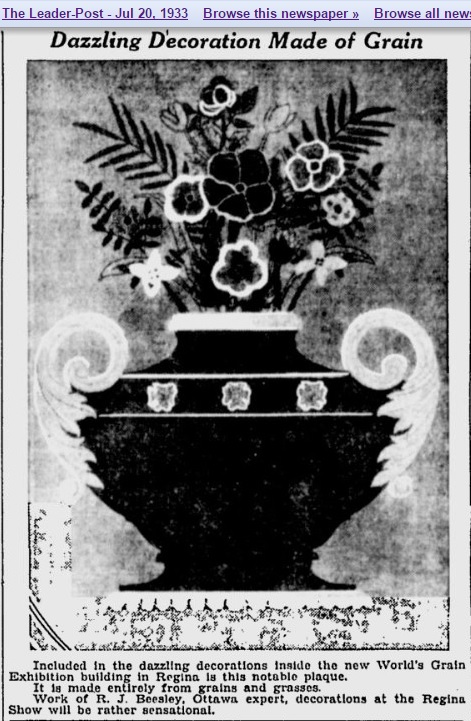 These decorative grain murals were probably sent back to Ottawa after the show.
These decorative grain murals were probably sent back to Ottawa after the show.
Fortunately. a collector of World’s Grain Exhibition memorabilia has contributed three photos of postcards to my blog which were on sale in 1933. They show interiors of the building at the time of the exhibition.
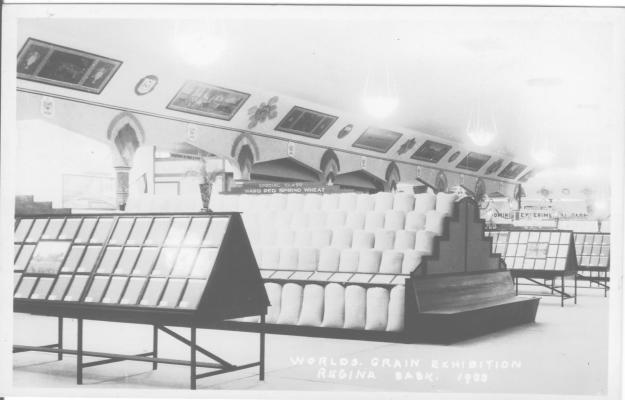

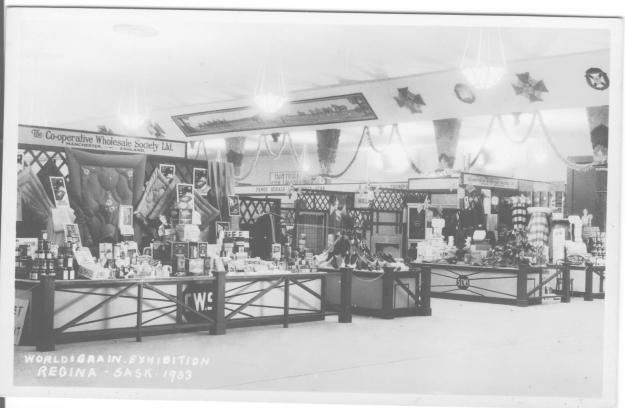
The National Gallery Show
A major travelling art exhibition was displayed in the Grain Show Building, a very large collection of 150 Canadian paintings from the National Gallery. I believe this display was the most extensive collection of Canadian art to ever be shown in Saskatchewan at one time and received a lot of press coverage: Jul 20, Jul 21, Jul 22, Jul 24, Jul 25, Jul 26, Jul 26b, Jul 28, Jul 31, 1933 editorial and Jul 22 & Aug 2 Star-Phoenix, Aug 4, 1933 Leader. Part of the show travelled to the Saskatoon summer fair after being shown in Regina. Norman Mackenzie, the tall man seen to the left of Lord Bessborough below, arranged to have the show assembled for the Grain Exhibition.
Little is mentioned about any local art exhibitions or competitions at the fair except for J.H. Lee-Grayson’s display at the tea room on the Exhibition Grounds. Jul 28, 1933 LP. The amateur art competition may have been foregone in favor of the massive handicraft exhibition (see below). However, there was a prize competition for local amateur photography Jul 28 and the usual prizes for amateur household industries and crafts. A show of paintings by Alberta’s Roland Gissing was on display in downtown Regina at Clay’s Art Studio during the fair. Jul 29, 1933
The Handicraft Exhibitions
Apart from the special travelling show of National Gallery paintings, there was a very special display of handicrafts held at the World’s Grain Show. Much of the Saskatchewan handicraft show was co-ordinated by the Women’s Art Association of Saskatchewan, although special craft displays were arranged by the Saskatoon Arts and Crafts Society and the Saskatchewan Homemakers’ Clubs.
The W.A.A.’s organizing started early. On Apr.29, 1933 an announcement appeared about what the WAA was interested in obtaining for the exhibition. On May 5 in SP & May 12, 1933 in Leader Post a request for submissions went out and May 31, 1933 an update on progress appeared. On Jun 22, 1933 a set of rules for submissions was published and other updates on progress were published Jun 23 and on Jun 27, 1933 Star-Phoenix. More updates published before the actual exhibition were on Jul 7 LP and Jul 11, 1933 SP. I reproduce here an announcement about the nature of the handicraft exhibit from the Jul 7, 1933 edition of the Regina Daily Post.
The Leader ran an editorial on the Handicraft section of the fair on Jul. 27, 1933 and selected articles about the handicraft exhibition are; Jul 24, Jul 26, Jul. 27, (There are several articles on craft and china on this page and the next) Jul 28, Jul 29, 1933 SP (The latter is an article that appeared in both Regina and Saskatoon on Alberta wood sculptor, W. H. Hodgson), Aug. 1, Aug.1b, Aug.8, 1933 LP
China displays Jul 24, 1933, LP, Jul 28 & 29, 1933 in the Star Phoenix.
Homemakers’ Clubs – Aug.1, 1933 SP
The Indian Exhibits
While the indigenous people also showed handicrafts at the World’s Grain Show, their contribution was, as usual, labelled and displayed separately from the settler craft shows. Their very presence at the Show was an exhibition in itself, as this article (jul 26, 1933) and these editorials from the Leader demonstrate: Jul 22, 1923 & Aug 1, 1933 (please note another opinion piece to the right of this one on the page written by someone with initials M.B.C.). In the planning stages for the exhibition organizers thought that a recreation of the Battle of Batoche using tribal visitors to the fair might be a good attraction. I’m assuming that someone with a sense of decorum put the kibosh on that silly idea, as this did not transpire. Mar 8, 1933.
Descriptions and prize lists for the craft exhibits can be found in the Leader Post on Jul 26, 1933, Jul 28, 1933, Aug 1, 1933,
The City and the Legislature
Although the exhibition was held at the Exhibition Grounds in Regina, the grain conference itself was held in various buildings in downtown Regina and the civic government and citizens went all out in sprucing up the city, anticipating many thousands of visitors coming to Regina. May 2, 1933 & Jun 17, 1933. The extent of civic decoration is described in a Jul 20, 1933 article.
A tent city was set up for visitors to the fair who could not be accommodated in hotels or billets. See these articles from Aug. 1 & Aug 1, 1933 which gives a real sense of what staying in the tent city was like.
The Legislature then had a Minister of Public Works who was very interested in art, J.F. Bryant, and he arranged for the legislative art collection to be properly displayed and catalogued to welcome visitors to Saskatchewan. He also commissioned a new mural for the building, which was in place just before the commencement of the World’s Grain Show. Aug.1, 1933 Leader.
There are lots of aspects of this fair covered in the Regina and Saskatoon newspapers and because reporters were there from many outside newspapers, I assume articles about the World’s Grain Conference and Exhibition can be found in other Canadian and American newspapers from July 24 – Aug. 4, 1933. But from my brief perusal of the Vancouver Sun, Ottawa Citizen and Calgary Herald, the best news coverage can be found in Saskatchewan.
*****************************************************************************
An avid student and collector of the World’s Grain Exhibition has contacted me (2018) and provided some new material for this blog post. There is an essay below and some photos of collectibles provided by him which I have attached here. Thank you very much. If you are interested in the memorabilia shown here or comments raised in his essay, please contact me and I will forward comments to the contributor.
The World’s Grain Exhibition and Conference
The World’s Grain Exhibition was the first, and ultimate, international contest and forum where countries that grew extensive crops of grains, grasses, pulses, and root and garden vegetables could exhibit seeds in competition and participate in a conference for learning and the exchange of knowledge. The event was developed and sponsored by the Government of Canada. Its theme “Show what you grow and share what you know” was prominent in the invitation sent to countries around the world.
Individuals were invited by Canada to compete and to attend; countries were asked to send delegates, display the country’s export products and depict its own natural surroundings. There were 54 competitive classes for seed exhibits and a competition for educational displays by countries. The overall event, planned for 1932 but delayed, was the main attraction at the Saskatchewan Provincial Exhibition, Regina, in 1933.
To display exhibits, Canada’s government had the Grain Show Building built at the fairgrounds. The building, with 150-thousand square feet of open space, had a temporary post office that sold the official grain show postage stamp and franked envelopes for enthusiasts. There were two off-site venues for the conference; one location for the technical proceedings of interest to growers, transporters, and manufacturers; another location for scientific presentations and discussions for researchers and educationalists.
Entrants for the exhibition competitions had to send quantities of seed in advance for pre-judging inspection and germination testing, this done at Dominion Experimental Farms. There were hundreds of classes for entries and thousands of exhibits entered; two-hundred-and-ninety-five alone competed in Hard Red Spring Wheat, the class for Show Champion. Prizes were cash. In total $100,000 was distributed. The list of all awards made for individual classes is thirteen pages in the National Committee Proceedings that records the entire event.
In all, thirty-two countries sent delegates and twenty of those countries provided educational displays, some of which highlighted their products for export. The display by Siam got rated “outstanding.” The grain exhibition itself took up three-and-a-half acres of display space, was open two weeks, and free to fairground patrons. The Regina Exhibition Association estimated attendance to the grain show as 193,000 fair goers. The Great Depression had caused financial difficulties that necessitated delaying the original start date. It also resulted in several countries having to reluctantly withdraw their application to attend. Nevertheless, the event was acclaimed a worthwhile undertaking, although it remained a one-off.
After the event, the Art Deco design Grain Show Building remained, for many years, the main display space at Regina’s summer fairs and, in part, a curling rink in winter. Over time its interior became shabby, although, on a continuous panel above the support columns the series of murals – original paintings of Canadian scenes – stayed fresh. Those works, by nationally noted artists, were a legacy of the event. In time, separate fires destroyed the building, in part and then in total. The art legacy was lost.
Today, much of the site has been re-purposed into a sports venue. Nothing remains of the 1933 Grain Show Building that had stood to the left of its neighbour, Confederation Park, which is now a preserved green space. Few current Regina citizens remember the Grain Show Exhibition. And presently there is no historical site marker to honour it
Nowadays international events are commonplace and travel to them convenient. Imagine though how arduous a trip could have been for the delegate from Siam (Thailand). He might have been days travelling to a port of embarkation to board a ship that took weeks to arrive somewhere in North America where he could entrain and languish for days before getting to remote Regina. Perhaps his lack of fluency in English may have made his adventure stressful, different customs and social nuances may have bewildered him, and the foreign food might have seemed unpalatable. All that, his extended stay, and having to endure similar discomforts on his journey home must have seemed daunting.
The disappearance of any tangible local connections to the World’s Grain Exhibition leaves only its souvenirs and ephemera as reminders of the event. When such items turn up, many of them migrate to collections of those in organized groups with specialty collecting interests: post cards, or stamps, cinderellas, pins and badges, medals, or fairs’ ribbons, and prize lists. There is no known organized group whose members collect World’s Grain Exhibition material, although there are lone individuals who do collect this event’s items. For the benefit of readers, some pictures are included here that show a few items in the genre. If you have any artifacts or information about the event and its ephemera, or if you have questions about the topic, you’re invited to leave a comment. The statistical and administrative history of the exhibition is well documented, but it’s the unrecorded personal memories and cherished souvenirs that need to be accounted so the history is complete. If you have something, please “Share what you know.”
BR 4.03.18
For purposes of scale, the ribbon is about 8″ long, the medal 1-3/4″,
the Cinderella stamps, each 1-1/4″ wide, the decal 3-1/2 wide, and the
postage stamp i-1/4″ wide.
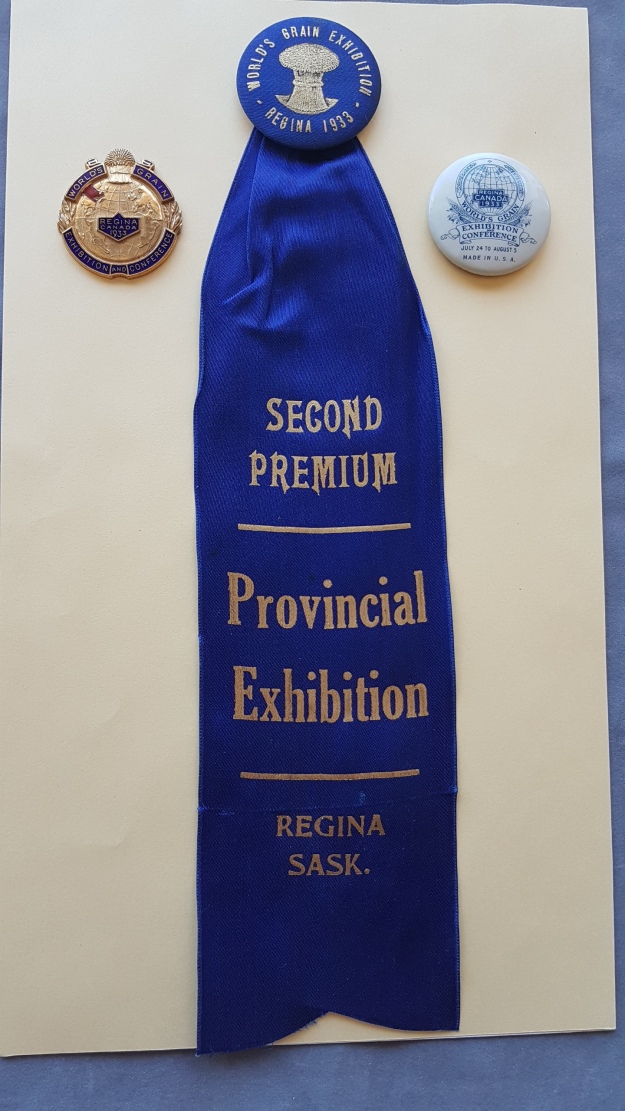
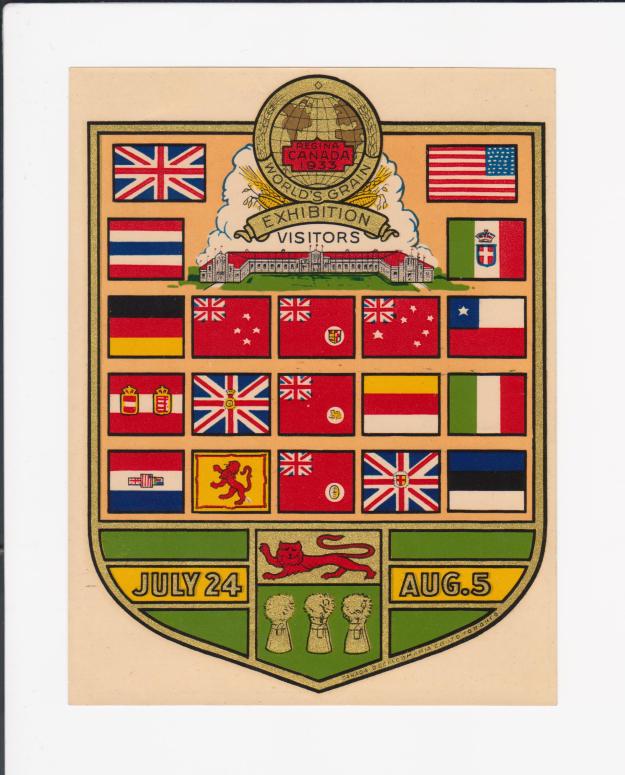

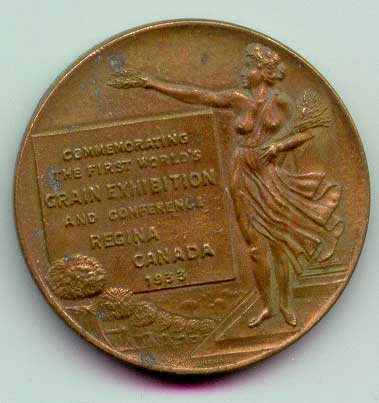
I am closing this out with a photo I found online of a commemorative plate you could buy at the 1933 fair.
©Lisa G. Henderson

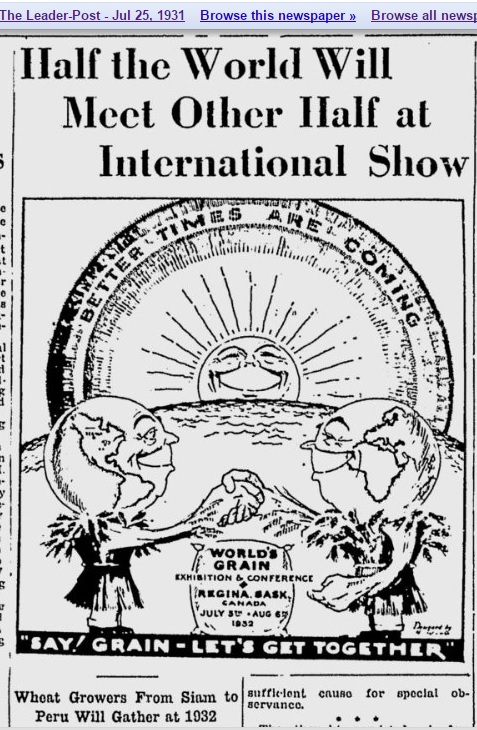
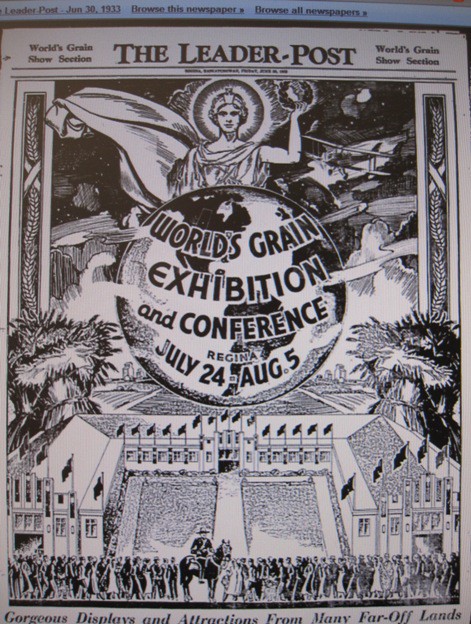



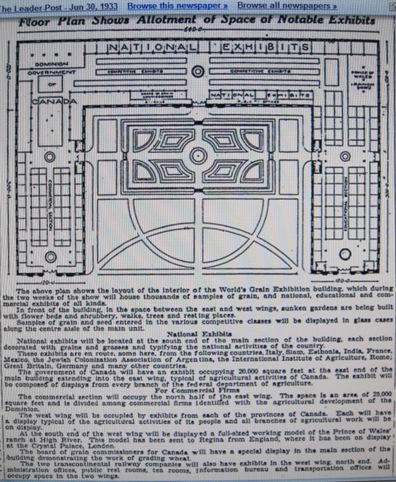
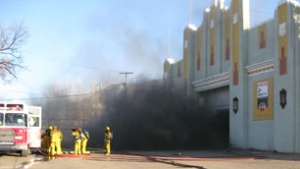
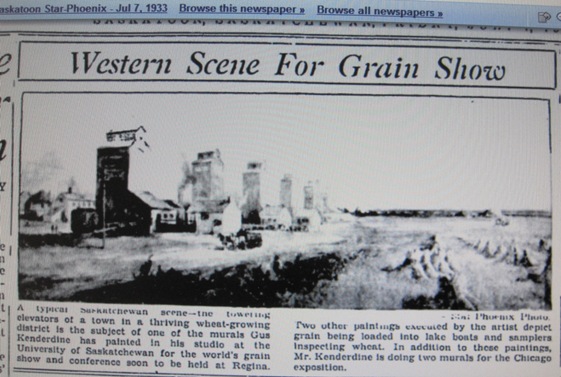
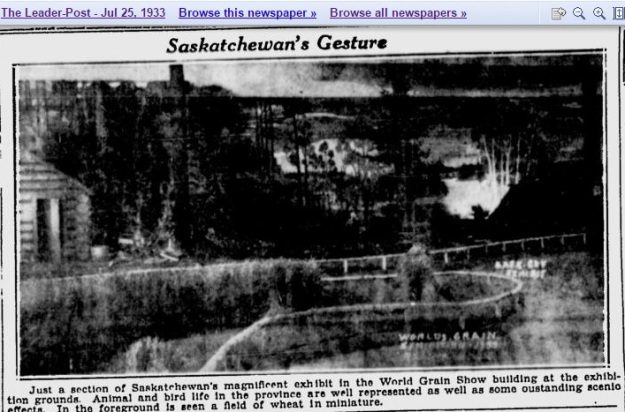

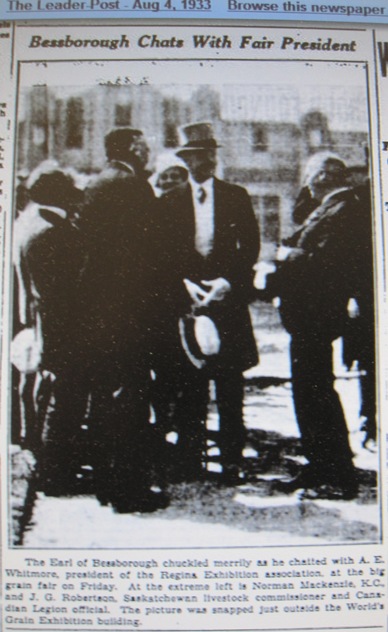
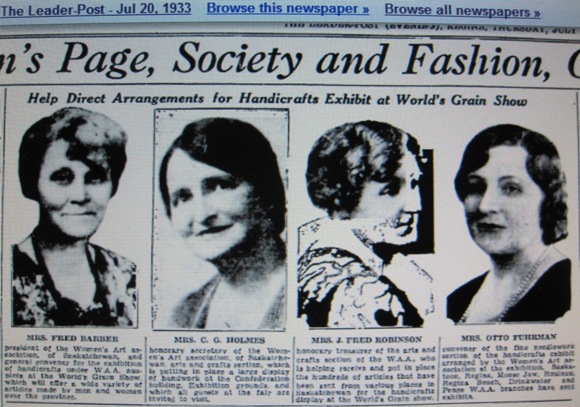

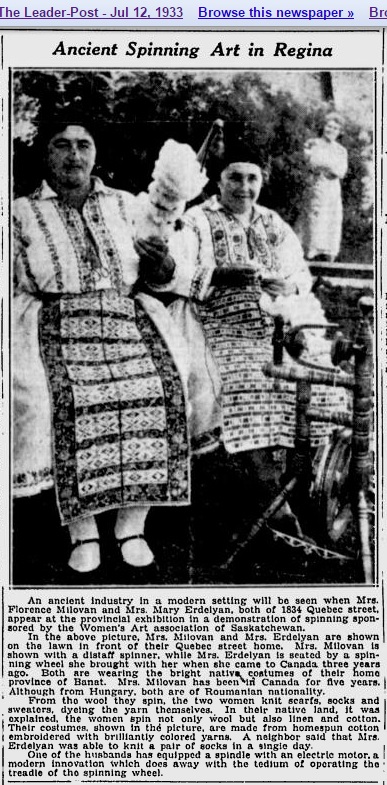


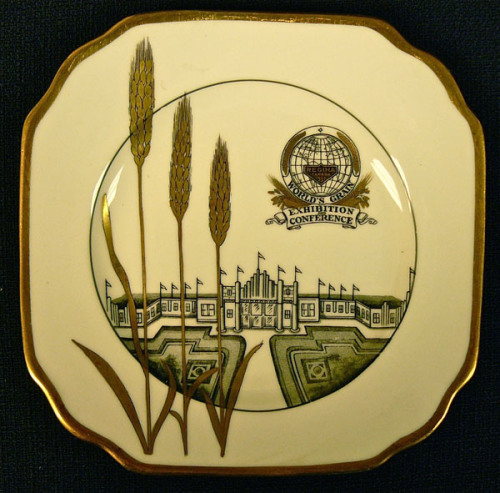
Do you know any history regarding Clay’s Art Studio? I may have just come across a Roland Gissing pastel. The pastel was framed at Clay’s on 12th ave. Regina. Thanks for any assistance.
LikeLike
Hello Paul. I checked my post Group and Solo shows in Regina and area to see if there was a record of a Gissing show in Regina in the newspaper. Didn’t see one but I did notice that Clay’s Art Studio was very active in the 1930s with exhibitions. I know I saw lots of ads for it in the Leader Post in the 1930s. Prior to the 1930s, there was a Laubach Art Studio in Regina which did framing but it seems to have expired in the 1920s so it is likely that Clay Art Studio opened after Laubach closed. You may know that Gissing kind of gave up pastels after 1930 (Max Foran – Roland Gissing – The peoples Painter). Thanks for reading my blog
LikeLike
To Lisa: I may be able to help with your search for WGE material. I collect memorabilia of that exhibition. If interested, email me under the subject WGE Regina. I can respond with information.
LikeLike
I have seen Clay’s sticker on the back of some old pieces of mine but can’t locate any, just checked 90 Flexies but seems to be too late . Eaton’s stickers appear often as do Willson’s Stationary in Regina on this very popular painter.
I lived in Regina starting in 1961 and have no memory of Clay’s. We bought our art supplies at Perry’s Art Centre
LikeLike
I run a Facebook group on Canada at World Fairs and Expositions and would like to get your approval to share your materials with my group. You have a wonderful and detailed report on this fair and I know my group would love to see these materials. Any materials posted will be credited to your site.
LikeLiked by 1 person
I would be happy to share my material with your group and would appreciate the reference to my site. I have sent you a private email, too, since there is a contribution from another individual on my blog post and he should receive credit too. Thanks. Lisa.
LikeLike